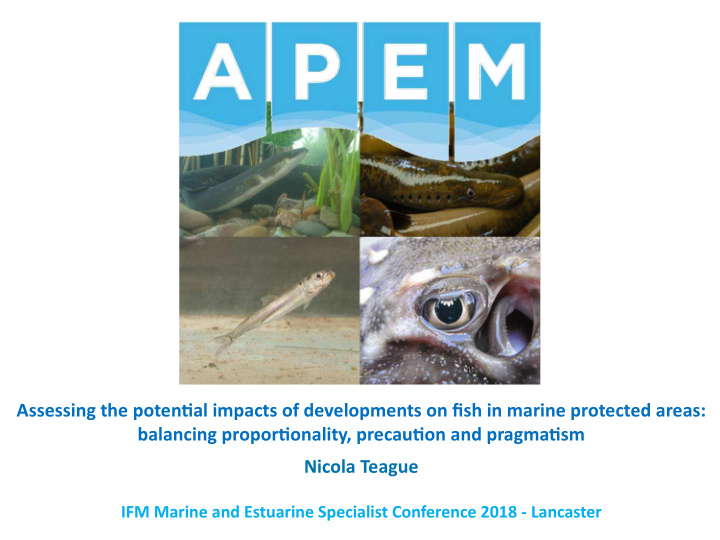



Assessing the poten,al impacts of developments on fish in marine protected areas: balancing propor,onality, precau,on and pragma,sm Nicola Teague IFM Marine and Estuarine Specialist Conference 2018 - Lancaster
Marine plans • Marine Plans developed for each UK administra6on Scotland • Wales (Dra;) • England • • 11 areas • Includes inshore (0-12 nau6cal miles) & offshore (12-c200 nau6cal miles) areas Cross-border interac6ons • • Common visions: Clean, healthy, safe, produc6ve & • biologically diverse oceans & seas Sustainable Development and • Sustainable Management of Natural Resources Point of reference for planning & licensing • decisions
Developments in the marine environment • Marine planning sector policies – planning sector development & growth in a sustainable manner Sea fisheries • Aquaculture • Oil & Gas • • Energy – Low carbon Offshore Wind & Marine Renewable • Energy Recreation & Tourism • Shipping, Ports & Harbours • • Submarine Cables Defence • Aggregates • Dredging & Disposal • Surface water & wastewater treatment & • disposal
Risk-based, proportionate & sound science Consistent key terms throughout all plans which influence how growth in the sectors • will be managed & assessed: Risk-based • Proportionate to risk of activity, spatial scale & location • Precautionary • Sound science • Relevant evidence of appropriate quality • Adaptive management – deploy & monitor • Ecosystem approach • Evidence of uncertainty • Multiple & cumulative impacts • ‘ Proportionate , consistent & integrated decision making through implementing • forward-looking policies as part of a plan-lead, precautionary , risk-based & adaptive approach to managing Welsh seas’ ‘Reliance on precaution should be minimised by best use of evidence. A high level of • precaution may be appropriate….sensitive or vulnerable habitats & species.’
Fisheries impact assessments • EIA HRA • WFD • Eels Regula0ons • Marine Permi8ng & Consen0ng • • MCZ assessment
Sound science, propor.onate to risk of ac.vity • Qualita've, expert judgement, semi-quan'ta've, quan'ta've What species are at risk, are they designated? • What is the scale & loca'on of the pressure? • Will the fish encounter the pressure & be impacted? • What is the risk of the impact e.g. disturbance, mortality, reduced survival, impacts on • reproduc've success etc.? Is there sound evidence on which to make an assessment? • Is the pressure & its impacts well defined or is it based on a novel sector? • Is there a risk to the stock/popula'on level? •
Robust evidence Encounter probability Interaction probability Impact severity Mortality rate No. of individuals lost Data/evidence requirements; • Is there empirical data to inform • modelling? Are there standard modelling • techniques? Can the models be validated? • Is there the required knowledge on • fish behaviour & movement Are the impact survival rates known? •
Understanding uncertainty Modelling has inherent uncertainty at • each step How can this be assessed & managed? • • Stochas:c modelling Empirical data • Valida:on • Do you need to understand • cumula:ve uncertainty? • Can you assess a poten:al impact without understanding the bounds of the impact due to uncertainty?
Impacts on populations/stocks Age structure of lost Equivalent Adult Stock/populaEon size individuals Values What % impact is % impact on stock/populaEon significant Impacts at ecosystem level What is the age structure of any losses and how • do these equate to EAV’s? How can age structure losses be assessed at an • ecosystem level? Is information available on stock & or population • sizes & boundaries? Is it possible to assess what is an acceptable • impact? What precaution/pragmatism should be applied? •
Acceptable thresholds of effect • What is an acceptable threshold of effect? Is a single threshold realistic/defensible? What can this value be based on? 1% vs other %’s • History of the 1% value? • Defining a significant part of a population when identifying sites that should be • protected under International legislation ‘any site which regularly holds 1% or more of a waterbird population qualifies • as being internationally important under the Ramsar Convention on Wetlands’ “ less than 1% of the total annual mortality of the population ” has been used by • the European Court when considering the scale of mortality to birds caused by hunting . The Court referred back to an EU scientific committee (ORNIS) that defined that value as being a ‘ small number ’ EU guidance - “ It was concluded that, as the habitat type was in decline, the • loss of even 1 % of habitat would be significant. ” The 1% value is used to screen out “ insignificant emissions ” to air potentially • affecting SACs, SPAs, Ramsar sites and SSSIs in the EA permitting process Windfarm bird collision risk modelling - Impacts of above 1% threshold of • baseline mortality triggers further analysis incorporating Potential Biological Removal (PBR)
Acceptable thresholds of effect • PBR - the maximum number of animals, not including natural mortali9es, that may be removed from a stock while allowing that stock to reach or maintain its op9mum sustainable popula9on. What impact does the loss have on the stock/popula9on? • Do all life stage losses effect the stock/popula9on & ecosystem in the same way? • • What loss to the stock/popula9on is a risk in terms of popula9on reduc9on or crash? Requires development & use of life cycle modelling •
Guidance Guidance is needed on the assessment requirements especially for poten5ally • high risk ac5vi5es in sensi5ve loca5ons What is defined as sound, robust science & best use of evidence & how can this • be demonstrated to minimise precau5onary applica5on? To what level does uncertainty need to be understood & presented? • Is there a consistent set threshold of effect? • • If not, how should it be determined at an individual sector, development, species level?
Recruitment plug Fisheries Ecologist Principal Consultant, Technical Specialist and Senior Scientist Salary: Competitive based on experience + Benefits Package Locations: Manchester, Cardiff, Cambridge, Oxford & Edinburgh Deadline: Monday 18th June 2018
Recommend
More recommend